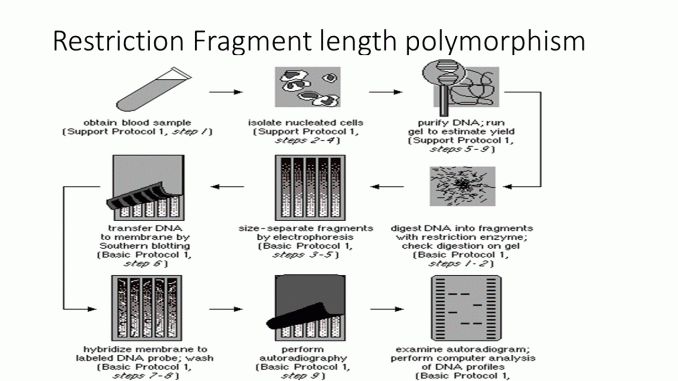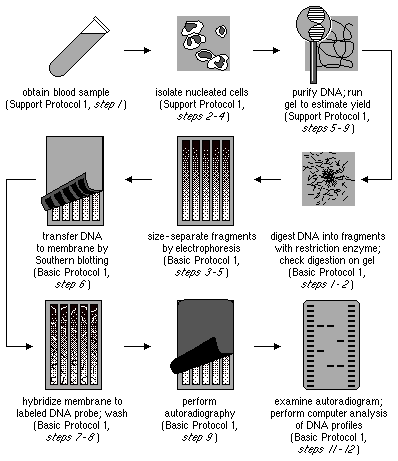
Restriction fragment length polymorphism (RFLP): principle, procedure and application
Principle of RFLP:
- RFLP is an enzymatic procedure for separation and identification of desired fragments of DNA. Using restriction endonuclease enzymes fragments of DNA is obtained and the desired fragment is detected by using restriction probes. Southern hybridization using restriction endonuclease enzymes for isolation of desired length of DNA fragments is an example of RFLP.
Procedures or steps of RFLP test:

Step I: Restriction digest
- Extraction of desired fragments of DNA using restriction endonuclease (RE).
- The enzyme RE has specific restriction site on the DNA, so it cut DNA into fragments. Different size of fragments are generated along with the specific desired fragments.
Step II: Gel electrophoresis
- The digested fragment are run in polyacrylamide gel electrophoresis or Agarose gel electrophoresis to separate the fragments on the basis of length or size or molecular weight.
- Different size of fragments form different bands.
Step III: Denaturation
- The gel is placed in sodium hydroxide (NaOH) solution for denaturation so that single stranded DNA are formed.
Step IV: Blotting
- The single stranded DNA obtained are transferred into charge membrane ie. Nitrocellulose paper by the process called capillary blotting or electro-blotting.
Step V: Baking and blocking
- The nitrocellulose paper transferred with DNA is fixed by autoclaving.
- Then the membrane is blocked by using bovine serum albumin or casein to prevent binding of labelled probe nonspecifically to the charged membrane.
Step VI: Hybridization and visualization
- The labelled RFLP probe is hybridized with DNA on the nitrocellulose paper.
- The RFLP probes are complimentary as well as labelled with radioactive isotopes so they form color band under visualization by autoradiography.
Application of RFLP test:
- Genome mapping: helps in analysis of unique pattern in genome for organism identification and differentiation. It also helps in determining recombination rate in the loci between restriction sites.
- Genetic disease analysis: After identification of gene for particular genetic or hereditary disease, that gene can be analyzed among other family members.
- To detect mutated gene.
- DNA finger printing (forensic test): It is the basis of DNA finger printing for paternity test, criminal identification etc.
